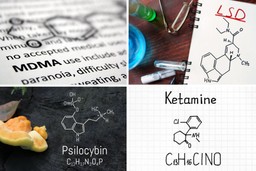You may be a psychonaut who has been entering non-ordinary states of consciousness to explore your mind for many years. Or you may be someone completely new to the world of psychedelics but curious about their effects and uses.
What do you want to know about psychedelics? Can they really treat mental health disorders? Are they safe? Legal? Is microdosing worth the hype?
These are some of the queries that even the top psychedelic researchers want to understand. This article tackles the most common questions people have about psychedelics. It summarizes the most recent evidence and provides links to our informative articles for in-depth learning.
1. What are psychedelics?
For someone who has never heard of psychedelics, let’s start with defining what they are. The term “psychedelic” is derived from the Greek words “psyche,” meaning mind, soul, or spirit, and “delos,” meaning to reveal or manifest.
Psychedelics are a class of substances that alter normal consciousness, mood, and various cognitive processes. They produce psychoactive effects that can change our thoughts and perceptions.
Psychedelics can be natural or synthetic. Some examples include psilocybin (found in certain mushrooms), LSD (lysergic acid diethylamide), DMT (dimethyltryptamine), MDMA (3,4-methylenedioxymethamphetamine), and others.
2. What are the different types of psychedelics?
You might be curious about the various psychedelics and how they are categorized. Psychedelics can be grouped as follows based on what the chemical structure of their molecule looks like.
- Tryptamines such as psilocybin and DMT
- Phenethylamines such as MDMA and 2C-B
- Lysergamides such as LSD
Psychedelics can also be categorized into pharmacological classes based on how they make you feel.
- Serotonergic psychedelics (5-HT2A receptor agonists) are known for producing altered perceptions and mystical experiences. Examples include LSD, psilocybin, and DMT.
- Empathogen-entactogens (serotonin releasers) are characterized by feelings of empathy, emotional openness, and increased sociability. Examples include MDMA and MDA.
- Dissociatives can induce a sense of detachment from reality. Examples include ketamine and phencyclidine (PCP).
You might think cannabis is a psychedelic, but it technically isn’t. It targets the endocannabinoid system and is in its own class.
Read about psychedelic therapy vs. medical cannabis.
3. Are psychedelics safe?
For years, the media has portrayed psychedelic substances as dangerous and their users as reckless hippies. In addition, the powerful effects of these psychedelic substances may have you wondering about their safety.
It’s difficult to answer this question with a yes or no. The safety of psychedelics depends on various factors. These include the specific substance, dosage, set and setting (the user’s mindset and the environment), and an individual’s health history. Here are some points to review when considering whether psychedelics are safe.
Physical Safety
Generally, classic psychedelics like psilocybin and LSD are not known to be physically toxic or harmful in moderate doses. However, certain psychedelic substances, especially highly potent synthetic phenethylamine hallucinogens drugs sold as psychedelics, may pose risks.
Pre-Existing Mental Health Conditions
Psychedelics can have powerful effects on mental and emotional states. While they are being studied for therapeutic use, there are potential risks, especially for certain individuals. Risks are higher for those with a personal or family history of mental health issues—such as schizophrenia or bipolar disorder.
For instance, new research shows that individuals with bipolar disorder who take psilocybin may be at risk of worsening symptoms.
Psychosis is sometimes a side effect of a psychedelic experience. Therefore, those who are prone to manic episodes or have psychosis previously should consult with their mental health care provider when deciding whether or not to use psychedelics.
Medical History
It’s important to understand that not everyone should take psychedelics. Depending on your current health condition and medical history, these psychedelic substances may put you at risk of harmful side effects.
Psychedelic substances can interact with certain drugs, altering their effectiveness and increasing the likelihood of negative effects. They are also not recommended for pregnant or breastfeeding individuals and those who are immunocompromised.
Learn more about who shouldn’t take psychedelics.
Adverse Reactions
An adverse reaction to psychedelics can cause extreme fear, anxiety, panic, and confusion. This is also sometimes referred to as a “bad trip”. This challenging experience can make the psychedelic user feel emotionally distressed. They have trouble making sense of what happened and recovering.
It’s been estimated that LSD and psilocybin have a safety ratio of 1000. This means that a fatal overdose would require about 1000 times more than for non-medical use.
However, a small number of deaths and serious adverse health effects have been associated with NBOMes, ibogaine, and PCP. More research is needed to distinguish whether these deaths were directly the result of the drug’s effect or due to contaminants and/or a combination of other drugs.
Dosage and Purity
Accurate dosing is crucial, as higher doses can lead to more intense experiences and increased risks. When dealing with psychedelic substances obtained from unregulated sources, purity and the absence of contaminants are important.
A contaminant such as fentanyl is odorless and colorless, which makes it difficult to detect. It’s not well understood whether current psychedelic drugs are being contaminated with fentanyl; however, it is possible. Harm reduction practices should be in place to minimize the risk of drug overdose risks.
4. Can psychedelics lead to addiction?
The Diagnostic and Statistical Manual of Mental Disorders, Fifth Edition (DSM-5) provides clinical professionals with criteria to diagnose a person with a substance use disorder and other psychiatric disorders.
Currently, it includes diagnoses of PCP use disorder and “other hallucinogen use disorder.” However, it does not include substance use disorder diagnoses related to other specific psychedelic and dissociative drugs.
A 2016 pharmacological review of psychedelics stated the following:
“[Psychedelic] substances do not lead to addiction or dependence and are not considered to be reinforcing. This is understandable when one realizes that the serotonergic hallucinogens do not have direct effects on brain dopaminergic systems, a pharmacology that appears essential for nearly all drugs that can engender dependence. Attempts to train animals to self-administer hallucinogens, an animal model that can predict abuse liability, have generally been unsuccessful.”
However, it’s important to differentiate classic psychedelics from dissociative and hallucinogenic substances that are often colloquially referred to as psychedelics. For instance, ketamine can have addictive potential, and frequent use may lead to tolerance and dependence.
5. What do psychedelics do in the brain?
Some people want to understand what happens in the brain if someone takes psychedelics. Psychedelics primarily interact with the serotonin system in the brain, particularly the serotonin 2A receptor (5-HT2A).
Here’s a brief overview of the neurobiological mechanisms and their impact.
Serotonin Receptor Activation
Psychedelics, such as psilocybin, LSD, and DMT, primarily work by binding to serotonin receptors in the brain. The 5-HT2A receptor is especially important in mediating the psychedelic effects.
Increased Neurotransmitter Release
Activation of the 5-HT2A receptor leads to an increased release of neurotransmitters, particularly serotonin. This flood of serotonin contributes to altered mood and sensory perception.
Changes in Brain Connectivity
Psychedelics induce changes in brain connectivity. They seem to weaken the default mode network (DMN), a network associated with self-referential thoughts and the sense of ego. This can lead to a sense of interconnectedness and ego dissolution.
Altered Perception
Psychedelics can induce perceptual alterations, such as enhanced colors, patterns, and a blending of sensory experiences called synesthesia.
Elevation of Consciousness
Many users describe a sense of expanded consciousness or a feeling of connection to something greater than themselves. This can lead to profound mystical or spiritual experiences.
Neuroplasticity and Therapeutic Potential
There’s growing interest in the therapeutic potential of psychedelics. Research suggests that psychedelics may promote neuroplasticity which is the ability for neurons to grow, reorganize, and change. Psychedelics can potentially rewire thought patterns, reduce symptoms, and contribute to long-lasting improvements in mental health disorders.
Ongoing research is providing more insights into how psychedelics interact with the brain—and how these relate to their various effects.
6. Can psychedelics treat mental health issues?
Research on the therapeutic potential of psychedelics for conditions like depression, anxiety, PTSD, and addiction is still in its infancy and ongoing. The results of recent studies suggest that psychedelics may hold promise for the treatment of various mental health issues and substance use-related conditions. Here are some key areas where psychedelics are being explored.
Depression and Anxiety
Psilocybin has shown promising results in treating depression and anxiety in clinical trials. The potential mechanism involved is the influence of psychedelics on brain networks associated with mood regulation.
Post-Traumatic Stress Disorder (PTSD)
Studies have shown that MDMA-assisted therapy has shown positive results in treating PTSD in clinical trials. It is suggested that MDMA may enhance the therapeutic process by reducing fear and defensiveness.
Addiction
Psilocybin and other psychedelics have been investigated for their potential to help individuals overcome addiction—for alcohol use disorders particularly. It is proposed that psychedelics may induce a profound shift in perspective and increase motivation for change.
End-of-Life Care
Psilocybin has been studied for its ability to ease anxiety and improve the quality of life in palliative care. It has also been studied to help individuals with life-threatening illnesses. The psychedelic experience may help individuals confront existential concerns.
Obsessive-Compulsive Disorder (OCD) and Eating Disorders
The studies relating to these disorders are ongoing. However, some early research suggests that psychedelics may have the potential to treat conditions like OCD and certain eating disorders.
Ultimately, the field is still evolving—more rigorous clinical research is required to establish the long-term effects of these treatments. We need to wait before we can conclude psychedelics as mainstream treatments for mental health conditions.
7. What is psychedelic-assisted therapy?
Psychedelic-assisted therapy involves the use of psychedelics in a therapeutic setting, guided by trained professionals. This approach has gained attention for its potential in treating various mental health conditions.
The therapy session is typically accompanied by integration sessions and psychological support. These are to help individuals make sense of their experiences and apply insights to their daily lives. It’s important to note that psychedelic-assisted therapy is a rapidly evolving field—research is ongoing to understand its efficacy and safety.
If you’re interested in learning more, you can explore online psychotherapy training programs to earn psychedelic-assisted therapy certifications.
8. What is microdosing, and does it work?
Microdosing has gained popularity in recent years. It is the practice of taking small, sub-hallucinogenic doses of psychedelics. The goal of microdosing is not to induce a full psychedelic experience but to experience subtle benefits.
How Microdosing Works
Typically, this means ingesting between 5 and 10 percent of a standard dose a few times a week. Common psychedelic substances involved in microdosing include psilocybin, ayahuasca, LSD, MDMA, mescaline, and DMT.
Psychedelics influence serotonin receptors. In microdosing, it’s hypothesized that these psychedelic substances may cause neural pathways to grow and change and reduce inflammation. These changes are without causing the hallucinogenic effects associated with higher doses.
Reported Benefits of Microdosing
There are plenty of anecdotal reports on the potential benefits. This ranges from Reddit forums and celebrities sharing their stories on social media to entire podcasts dedicated to microdosing.
Some of these include increased creativity, improved mood, enhanced focus, better sleep, improved anxiety and depression, and a general sense of well-being.
Evidence and Research
While anecdotal reports are abundant, rigorous evidence, such as clinical studies on microdosing, is still limited. Some small-scale studies have explored the cognitive effects and safety of microdosing, but more research is needed.
Because the effect of microdosing is sub-perceptual, those who report benefits could be influenced by the placebo effect. In addition, responses to microdosing can vary widely between individuals. Factors such as dosage, frequency, and individual neurochemistry may play a role.
While microdosing is generally considered safe, there’s still uncertainty about its long-term effects. Indeed, microdosing shows promise—particularly in anecdotal reports. However, the bottom line is that more research is needed to fully understand its potential risks, mechanisms, and efficacy.
Learn more about where the research stands now on microdosing psychedelics.
9. What is set and setting in the context of psychedelic experiences?
“Set and setting” is a foundational concept in the context of psychedelic experiences. It emphasizes the importance of one’s mindset (set) and the physical and social environment (setting) in which psychedelic experiences occur. This concept was popularized by Timothy Leary, a Harvard researcher and key figure in the psychedelic movement.
Set (Mindset)
Set refers to the mental and emotional state of the individual before taking a psychedelic substance. Preparation of a positive and open mindset is often associated with more beneficial and meaningful experiences.
Setting intentions for a psychedelic experience can be helpful in creating a mindful journey. This might include seeking personal insights, healing, or spiritual exploration.
Setting (Environment)
The physical environment includes surroundings where the psychedelic experience takes place. Users find that a comfortable, safe, and aesthetically pleasing environment can contribute to more positive experiences.
The environment should take into consideration safety measures. Ensuring that the setting is free from potential hazards and disturbances. This includes considerations such as lighting, temperature, and access to basic needs.
The social presence and behavior of others can significantly influence the experience. Having an experienced trip sitter or a trusted and supportive guide can enhance feelings of safety.
In therapeutic settings, the set and setting are carefully curated to maximize therapeutic outcomes. Trained therapists guide individuals through the experience, and the physical environment is designed for safety, comfort, and conduciveness to introspection.
Understanding and respecting the principles of set and setting is considered essential for anyone engaging in psychedelic experiences. It contributes to a more positive, meaningful, and potentially transformative journey.
10. What are the legal status and regulations of psychedelics?
Anyone considering the use of psychedelics—whether recreationally or therapeutically—should do thorough research, and be aware of the legal implications.
The legal status of psychedelics varies widely. Some, like psilocybin, are illegal in many places; however, other substances, like ketamine, may have legal medical uses. Laws regarding psychedelics vary widely—people often seek information on the legal status of different psychedelic substances and recent changes in regulations.
Learn more about how to get legal psychedelic therapy.
Psychedelics are powerful substances that require a responsible and informed approach. Research into the therapeutic potential of psychedelics is ongoing. These substances are not yet widely accepted as conventional treatments.
We recommend you consult with a healthcare professional and work with a trained professional who has proper experience administering psychedelics.
Check out our vetted online directory of providers today!
Follow your Curiosity
Sign up to receive our free psychedelic courses, 45 page eBook, and special offers delivered to your inbox.References
Abuse, N. I. on D. (2023, April). Psychedelic and Dissociative Drugs. National Institute on Drug Abuse. https://nida.nih.gov/research-topics/psychedelic-dissociative-drugs#drugs-safe
Hartogsohn, I. (2017). Constructing drug effects: A history of set and setting. Drug Science, Policy and Law, 3, 205032451668332. https://doi.org/10.1177/2050324516683325
Huber, B. (2013). What do we know about the risks of psychedelics? Michaelpollan.com. https://michaelpollan.com/psychedelics-risk-today/
Nichols, D. E. (2016). Psychedelics. Pharmacological Reviews, 68(2), 264–355. https://doi.org/10.1124/pr.115.011478







